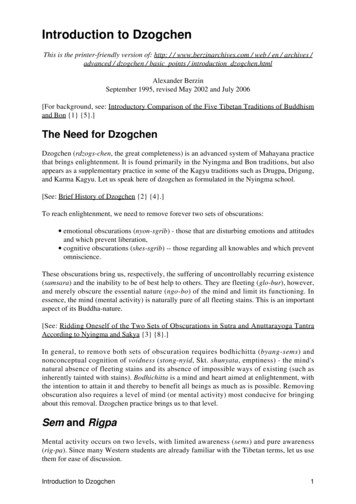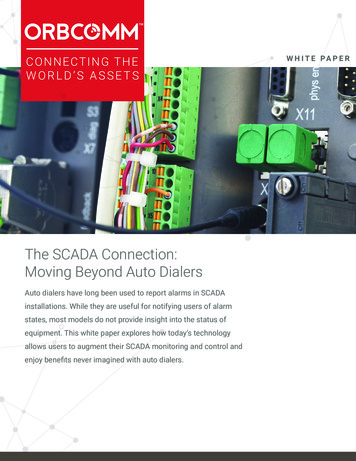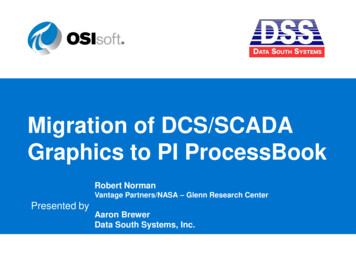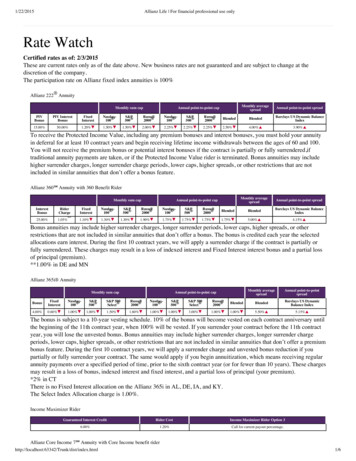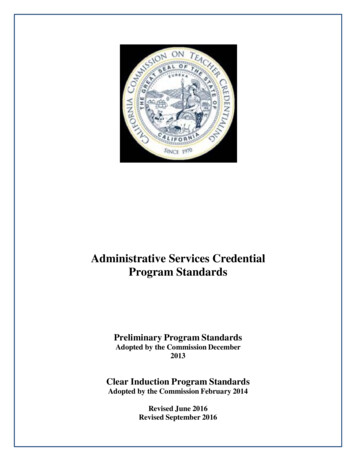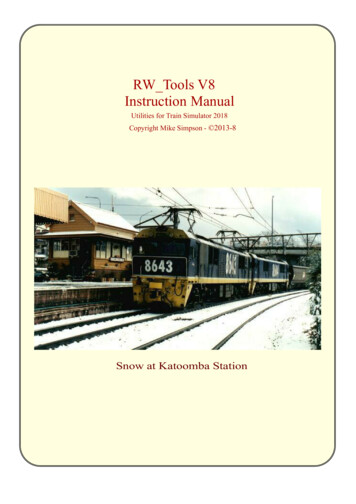
Transcription
DNP3: SCADA, Clear and SimpleAndrew West, Regional Technical Director, SUBNET SolutionsChair, DNP Technical CommitteePEAC, March 2020 Copyright SUBNET Solutions Inc. 2020
Agenda Introductions DNP3 philosophy & terminology Lesser-known features Current developmentsPEAC, March 2020 Copyright SUBNET Solutions Inc. 2020
IntroductionsPEAC, March 2020 Copyright SUBNET Solutions Inc. 2020
Contact DetailsAndrew WestRegional Technical Director, Asia-PacificSUBNET Solutions Pty LtdAndrew.West@SUBNET.comPEAC, March 2020 Copyright SUBNET Solutions Inc. 2020
IntroductionsWho are you?What do you do?Why are you here?PEAC, March 2020 Copyright SUBNET Solutions Inc. 2020
DNP3 philosophy & terminologyPEAC, March 2020 Copyright SUBNET Solutions Inc. 2020
Programmers beware! DNP3 terminology uses terms differently from their meanings incommon object-oriented programming languages Also: Different protocols use terms differently Familiarity with one protocol can lead to confusion when looking at others Confusion often occurs with: Objects Types ClassesPEAC, March 2020 Copyright SUBNET Solutions Inc. 2020
Terminology: Master StationDNP3 Master Master Terminal Unit (MTU) Human Machine Interface (HMI)20 AIADIO/I ITLUM (previously MMI: Man Machine Interface) Controlling Station Control Centre Equipment Front-End Processor Typically the communications interface SCADA ClientPEAC, March 2020 Copyright SUBNET Solutions Inc. 2020
Terminology: Field Equipment Remote Terminal Unit (RTU)RemoteSlaveControlled StationDNP3OutstationData Concentrator (DCIU)SCADA ServerIED: Intelligent Electronic DevicePLC: Programmable Logic ControllerPEAC, March 202020 AIADIO/I ITLUM Copyright SUBNET Solutions Inc. 2020
DNP3 Device identification Each DNP3 device (master or outstation) has a DNP3 address DNP3 addresses are 2-octets or 16-bits in size (range 0 to 65,535 or 0x0000 to0xFFFF) Each device is assigned an address in the range 0–65,519 (0x0000-0xFFEF) Addresses 65,520–65,535 (0xFFF0-0xFFFF) are reserved for broadcast andspecial functions No device may be assigned one of these addresses DNP3 addresses appear as “source” and “destination” address fields in theDNP3 data link frame of every message There is no implicit meaning to any address other than the reservedaddresses: any master or outstation has any address 0–65,519PEAC, March 2020 Copyright SUBNET Solutions Inc. 2020
DNP3 Device identification DNP3 addresses are unique on a serial link A single physical device may respond to multiple DNP3 addresses, eachappearing to be a separate “logical” device DNP3 addresses are unique to each logical device that is accessedthrough a single IP address Terminal servers may connect multiple serial devices “behind” a single IPaddress A device with a single IP address may contain multiple DNP3 devices, each ofwhich is considered a separate logical devicePEAC, March 2020 Copyright SUBNET Solutions Inc. 2020
Supported TopologiesMuti-master20 AIADIO/I ITLUM20 AIADIO/I ITLUMOne to OneHeirarchical /Data Concentrator20 AI20 AI20 AIADIADIO/I ITLUM20 AIADIADIO/I ITLUMO/I ITLUMO/I ITLUMMultidrop20 AIPEAC, March 2020ADIO/I ITLUM20 AIADIO/I ITLUM Copyright SUBNET Solutions Inc. 2020
DNP3 Device identification Devices can be uniquely identified by: Combination of DNP3 address and serial channel Combination of DNP3 address and IP address From the master’s viewpoint, each different outstation address on asingle serial link or “behind” a single IP address is a different device An “Association” is the combination of a master and an outstationwith which it communicates Each association requires separate “housekeeping” Initialization status Message sequence numbers Secure authentication managementPEAC, March 2020 Copyright SUBNET Solutions Inc. 2020
DNP3 Data Model & Data Types DNP3 models data in terms ofone-dimensional arrays of dataper outstation: Binary inputs & outputsAnalog inputs & outputsCounter inputs (running & frozen)Blob (“string”) objectsData sets (structures of data) Data identified by Outstation, data type & indexPEAC, March 2020 Copyright SUBNET Solutions Inc. 2020
Data Identification Each data object (e.g. an individual binary input) is called a “Point” Data for a point has a value, quality and time of measurement For each data type (binary input, analog input, etc.) “Static” data reports the current state of the point Static does not mean “unchanging”, it just refers to the current “state” of the point “Event” data reports a change or an update of the state of the point Events might or might not indicate a change of state Events are sent for any reason the outstation determines is worth reporting PEAC, March 2020Change of valueChange of qualityPeriodic updateEtc Copyright SUBNET Solutions Inc. 2020
Data Identification Static and event data in DNP3 messages are reported using different“Object Groups” Each Object Group has an identifying object group number E.g. Binary Input static data is Object Group 1 & binary input event data isObject Group 2 Object Groups indicate how to report data for each data type The associated static and event object groups for a specific index ofany data type update the value of the same pointPEAC, March 2020 Copyright SUBNET Solutions Inc. 2020
DNP3 Object Groups For example: Binary input static data for index 3reports the current value of the 4thbinary input (indices start at 0) Binary input event data for thesame index updates the value ofthat same binary input Event data is stored in andreported from an event buffer When a timestamp is reported, itis the time of data updatePEAC, March 2020 Copyright SUBNET Solutions Inc. 2020
DNP3 Object AC, March 2020DescriptionDevice AttributesBinary InputBinary Input ChangeDouble Binary InputDouble Binary Input ChangeBinary Output StatusBinary Output EventControl Block (Binary Output)Binary Output Command EventBinary CounterFrozen CounterCounter Change EventFrozen Counter EventAnalog InputFrozen Analog InputAnalog Change EventFrozen Analog EventAnalog Input Reporting DeadbandAnalog Output StatusAnalog Output BlockAnalog Ouptut EventAnalog Output Command ntEventStatic 6878890100101102110111112113120DescriptionTime and Date - All VariationsTime and Date CTO - All VariationsTime Delay - All VariationsClass DataFile TransferInternal IndicationsStorage ObjectDevice ProfilePrivate Registration ObjectData Set PrototypeData Set DescriptorData Set Present ValueData Set SnapsotApplication IdentifierFloating Point (obsolete)Packed Binary-Coded DecimalUnsigned 8-bit IntegerOctet StringOctet String EventVirtual TerminalVirtual Terminal EventAuthenticationTypeInfo R/W(Event)InfoCommandInfo R/WStatic aticStaticStaticEventWriteEventInfo Copyright SUBNET Solutions Inc. 2020
DNP3 Data Object Structure For point data: An Object Group can report data in various formats Analog inputs can be 16-bit integer, 32-bit integer or 32-bit or 64-bit floating point Counters can be reported as 16-bit or 32-bit values The different formats are known as “Variations” (identified by a number) Any point can theoretically be reported in any variation A specific analog input could be reported as a 16-bit or 32-bit integer or as a float: Thesame value would be reported in whichever variation is used (subject to scaling,overflow, rounding, etc.) Each point has a default variation (which may be configurable) A master may request the variation it wants reported Variation 0 is specified in read requests to mean “any variation” (use default)PEAC, March 2020 Copyright SUBNET Solutions Inc. 2020
DNP3 Data Object Structure Point data objects typically consist of: Value Qualifier flags Timestamp (optional: events & frozen objects only) For Static data: Some variations include qualifier flags, some don’t When qualifier flags are not reported, this means exactly the same as a variation withflags indicating “On-Line with no errors” In all cases, the Variation number indicates the format of the dataobject in the messagePEAC, March 2020 Copyright SUBNET Solutions Inc. 2020
DNP3 Data Object Structure 5 common flags: On LineRestartCommunication LostRemote ForcedLocal ForcedNormal Status10000(used in all data types) Additional type-specific flags (all normally 0): Binary: Chatter Filter Analog: Overrange & reference error Counter: Discontinuity & rollover (rollover is deprecated)PEAC, March 2020 Copyright SUBNET Solutions Inc. 2020
Binary Input Variations Static (Object Group 1) Variation 1: Packed (index m–n) Variation 2: With Flags (per index) Event (Object Group 2) Variation 1: Without time Variation 2: With timeChatter Filter Etc PEAC, March 2020 Copyright SUBNET Solutions Inc. 2020
Analog Input Variations Static (Object Group 30) Variation 1: 32-bit with Flags Variation 2: 16-bit with Flags Etc PEAC, March 2020 Event (Object Group 32) Variation 2: 16-bit without time Variation 7: Short float with timeOverrangeReference Error Copyright SUBNET Solutions Inc. 2020
Polling Polling is typically a periodic process Requests are issued by the masterstation The outstation returns the data that isrequestedTime DNP3 supports polling by a masteror “unsolicited reporting” from anoutstation (or a mixture) An outstation may spontaneouslyreports changes to the master, insteadof being polledPEAC, March 2020 Copyright SUBNET Solutions Inc. 2020
Polling for Events Systems may: Ignore values occurring betweenpolls, return value at time of scan Report changes, including thosethat occur between polls (EventReporting or RBE)Static Poll 0 1 1 1 0 0TimeEvent Poll — 1 01 —010— after collectingthe initial 0 Analogs & counters Events may indicate a significantchange, a periodic update orwhatever the outstation decidesPEAC, March 2020(0 1 1 1 0 0)(— 1 01 —010—) Copyright SUBNET Solutions Inc. 2020
RBE Reporting Model All changes reported as events(with or without timestamps) Current value need only be collected atstart up or after data loss Use events for all SCADA data processes Update database Alarm processing HistoryPEAC, March 2020 Copyright SUBNET Solutions Inc. 2020
Data Handling Modern SCADA protocols use RBE Data reported is: {Value, Quality, Timestamp} Consecutive samples for each data object (point) is reported in thesame order it is read Master updates the database with data in the sequence received: the finalvalue is the most recent value Event buffer overflow requires re-initialization by reading all currentvaluesPEAC, March 2020 Copyright SUBNET Solutions Inc. 2020
Control Commands Single Pass Command Control command issued and immediately activated Subject to incorrect commands due to communications errorsCommandPEAC, March 2020Activate Copyright SUBNET Solutions Inc. 2020
Control Commands Two Pass CommandStep 1: (Select) “Select Before Operate” (SBO) or“Select Execute” The first command, Select, “arms” anoutput and the outstation responds The master receives response andchecks it If it is correct, the Operate or“activate” command is issued The outstation verifies that the“Operate” matches the “Select”ARMStep 2: (Operate)Activate Provides very high integrity againstincorrect commands due tocommunications errorsAll high integrity SCADA protocols support 2-pass controlsPEAC, March 2020 Copyright SUBNET Solutions Inc. 2020
Structures and Paradigms DNP3 is based on a set of paradigms: Report-By-Exception (RBE) An initial image of field data is reportedThereafter only “changes” are reportedUses communications bandwidth efficientlyRequires data identification in messages Uses a layered structure Data for each object is always reportedin the same order that it is measured Reporting of event data is confirmedPEAC, March 2020 Copyright SUBNET Solutions Inc. 2020
DNP3 Classes In DNP3, Classes are used to collect together various kinds of data Each class may be polled with a different period A single class, Class 0, is the set of all kinds of static data Class 0 may be considered to be identical to the set of static data for eachkind of data point in a device: Reading Class 0 is equivalent to reading all binary input static data and all analog inputstatic data and all counter input static data, etc. Some devices also include output point static data in Class 0 Note for programmers: Classes in DNP3 are not “data structures” DNP3 Object Groups and their Variations are “data structures” in messagesPEAC, March 2020 Copyright SUBNET Solutions Inc. 2020
DNP3 Classes Three classes, Classes 1, 2 and 3 are sets of event data The three classes may be considered as separate collections of points Each event class may be polled at a different period or at the same period Polling different classes at different periods assigns a different priority or maximum datalatency to the class There is no inherent ordering of priority of the event classes, the priority or periodicity ofreporting depends on the system configuration If events are to be reported for a point, its static value must be reported aspart of the Class 0 data for the device Event data is bufferedPEAC, March 2020 Copyright SUBNET Solutions Inc. 2020
DNP3 Classes Except for very small outstations, all DNP3 devices support eventreporting Small outstations are permitted to operate by only reporting static data If the largest possible response to a poll for Class 0 data fits in one DNP3 Data Link Frame(no more than 249 bytes of Application Layer data), then the outstation is not requiredto support event reporting Normal DNP3 operation is by Class Polling A combined poll for Classes 1, 2, 3 & 0 is an integrity poll (synch database) Required at startup or after buffer overflow, may be requested occasionally Events are periodically collected by requesting Classes 1, 2 and 3 periodically May be polled together or independentlyPEAC, March 2020 Copyright SUBNET Solutions Inc. 2020
DNP3 Classes Classes are “shorthand” descriptions for groups of other objects Class 0 is a shorthand reference meaning the same thing as specifying all thestatic data types Classes 1, 2 & 3 are groups of event objects Specifying a class is a shorthand way of specifying the set of objects that report events inthat class Allows selection of three different reporting priorities The master can read objects or classesPEAC, March 2020 Copyright SUBNET Solutions Inc. 2020
DNP3 Classes The purpose of Class 0 is to collect all device data at startup: Tocapture an “initial database image” Called “Integrity Poll”: Also collect events: Classes 1,2,3 & 0! All Static data is included in Class 0 Event Classes allow grouping or prioritization in whatever manner theuser chooses There is no implied priority of Event Classes It is possible to request a limited number of events in an event classpollPEAC, March 2020 Copyright SUBNET Solutions Inc. 2020
DNP3 Layers (EPA Model) Physical Media and network interfaces Data Link Handles link control, frame checks,addressingUser LayerApplication LayerData Link Layer Transport (function or pseudo-layer) Assembles application messagefragments Application LayerPhysical LayerCommunication Medium Defines DNP data objects and servicesPEAC, March 2020 Copyright SUBNET Solutions Inc. 2020
DNP3 Layer Terminology Data Link FRAME A complete data link message Transport SEGMENT A Data Link Frame with Transport Header Between DNP3 Application Layer and Data Link Layer Security (starting from SAv6): SPDU Application FRAGMENT A complete, parseable collection of Segments Application MESSAGE A complete message (one or multiple Fragments)PEAC, March 2020 Copyright SUBNET Solutions Inc. 2020
DNP3 Message ComponentsApplication Layer MessageDNP3-SATransportFunctionSegments1st FragmentApplicationLayerFragmentsT AHH.AH.TH2nd FragmentT AHHTH.AH.TH1stL T AHH HTHLast.L THHL THHL T AHH HL THH.L THHData Link Layer FramesTransmission sequenceA Application HeaderHPEAC, March 2020T Transport HeaderHL Link HeaderH Copyright SUBNET Solutions Inc. 2020
DNP3 Link Layer Usage For almost all applications: Only Unconfirmed User Data Service is used No need for any secondary messages No need to perform Reset Link States command Traffic is minimized Only use data link confirmation if required for flow control Usually only for devices that are unable to buffer a complete ApplicationFragmentPEAC, March 2020 Copyright SUBNET Solutions Inc. 2020
DNP3 Application Confirmation When reporting events, outstations request application confirm When the master confirms receipt of data, the reported events are clearedform the event buffer If not confirmed, the data remains buffered and is reported in a subsequent response When reporting a non-final fragment, outstations request app conf Receipt of the confirm indicates to the outstation that it is to transmit thenext fragment The final fragment will request confirm if it contains eventsPEAC, March 2020 Copyright SUBNET Solutions Inc. 2020
DNP3 Command Summary Data are collected by READ commands Data can also be reported in Unsolicited messages Output objects can be read Not usually required by all systems Time can be written Internal Indication “Device Restart” flag is cleared by writing it to zero Outputs are NOT issued by Write commandsPEAC, March 2020 Copyright SUBNET Solutions Inc. 2020
DNP3 Subset Levels Subset Levels provide a way for DNP3 to identify commonly used setsof objects and functions Subset Level 1 permits Class polls, commands Subset Level 2 permits Data Type polls and supports frozen counters Subset Level 3 permits individual object polling and adds someadvanced features Subset Level 4 includes all basic data typesNormal DNP3 Operation uses Subset Level 1 functionsPEAC, March 2020 Copyright SUBNET Solutions Inc. 2020
DNP3 Output Commands DNP3 Supports direct execute or Select-Before-Operate (1-pass and 2pass) commands on both binary outputs and analog outputs Binary outputs are controlled through the CROB (Object Group 12,Variation 1) Analog outputs are controlled through the analog output block(Object Group 41) It is permissible (but unusual) to issue multiple control commands inone messagePEAC, March 2020 Copyright SUBNET Solutions Inc. 2020
DNP3 Binary Outputs The CROB can accept many parameters The basic implementation permits: Trip/Close Latch On/Latch Off Pulsed contact closure Paired commands may be issued to one index or to a pair of indices The master is required to be configurable to match the outstation’srequirementsPEAC, March 2020 Copyright SUBNET Solutions Inc. 2020
Binary Output Models Activation model Control commands initiate an actionTo Event QueueBinary OutputCommand EventBinary OutputEventOutput StatusEvent DetectorBinary Output StatusValueChoice ofstatus sourcesCommandEvent Detector0WaveformDrivenDeviceLogicDevice DependentSBO Logic(If Applicable)Command From DNP3PEAC, March 2020Command fromNon-DNP3 Source Copyright SUBNET Solutions Inc. 2020
Binary Output Models Complementary Latch model Control commands operate to two statesTo Event QueueBinary OutputCommand EventBinary OutputEventBinary Output StatusValueOutput StatusEvent DetectorChoice ofstatus sourcesCommandEvent DetectorSetLogicSBO Logic(If Applicable)FFOrLatchDrivenDeviceResetDevice DependentCommand From DNP3PEAC, March 2020Command fromNon-DNP3 SourceNotes:1. FF means Flip-Flop (actual or virtual).2. Set and reset are arbitrary names having complementary meanings.3. The diagram is conceptual and other implementations are possible.CopyrightSUBNET Solutions Inc. 2020
Binary Output Models Complementary Two-Output model Control commands operate to two statesTo Event QueueBinary OutputCommand EventBinary OutputEventOutput StatusEvent DetectorBinary Output StatusValueChoice ofstatus sourcesCommandEvent Detector0DriverDrivenDeviceT/CLogicDriverSBO Logic(If Applicable)Device DependentCommand From DNP3PEAC, March 2020Command fromNon-DNP3 Source Copyright SUBNET Solutions Inc. 2020
DNP3 Unsolicited Reporting Outstation is permitted to spontaneously report events (and requestsmaster to issue confirm) Startup behavior changed in DNP3-1999: Outstation sends empty “restarted” message Master issues “enable unsolicited” command Prior behavior did not require “enable unsolicited” Collision avoidance and backoff Configure sensible backoff times!PEAC, March 2020 Copyright SUBNET Solutions Inc. 2020
DNP3 Poll Transaction SequenceApplicationLayerUserLaye rPollTransportFunctionData LinkLayerData LinkLayerTransportFunc tionApplicationLayerUserLayerRead requestfragmentUser data frameAckRead requestfr agment1Find dataRead response1st fragmentDataUser data f rameTimeAck1Ack1Ack1User data f rameUser data f rameRead response1st fragme ntDataConfirmAck1User data frameUser data f rameAck1Ack1Ack1ConfirmEventsconfirmedRead response2nd fragmentUser data f rameUser data f rameRead response2nd fragme ntDataConfirmAck1User data frameConfirmEventsconfirmed1Ack frames are transmitted only ift he user data fram es requi re confirmationPEAC, March 2020 Copyright SUBNET Solutions Inc. 2020
DNP3 Unsolicited “Response”UserLaye rApplicationLayerTransportFunctionData LinkLayerData LinkLayerTransportFunc tionApplicationLayerUnsolic itedresponseUserLayerEventsUser data frameTimeUser data frameUnsolic itedresponseUser data frameDataConfirmPEAC, March 2020User data frameConfirmEventsconfirmed Copyright SUBNET Solutions Inc. 2020
DNP3 LAN/WAN Usage DNP3 on LAN/WAN specification First published December 1998Specifies UDP/IP for single-segment LANsSpecifies TCP/IP for WANs and multi-segment LANsAssigned TCP/UDP port number 20000Adds time sync function for single-segment LANs Encapsulates “serial” DNP3 in an IP packet Adds 56-byte packet overhead in TCP/IPPEAC, March 2020 Copyright SUBNET Solutions Inc. 2020
DNP3 Operation over IPLogical CommunicationsMasterOutstationApplication FragmentDNP3 ApplicationLayerDNP3 ApplicationLayerTransport SegmentDNP3 TransportFunctionDNP3 TransportFunctionData Link FrameDNP3 Data LinkLayerDNP3 Data CP, UDPTransportTransportIPv4, IPv6, ICMP, IGMPNetworkNetworkDevice driver/hardwareLink/PhysicalLink/PhysicalDNP3 ProtocolDefined in DNP3SpecificationInternet Protocol SuiteTCP/IP NetworkPEAC, March 2020 Copyright SUBNET Solutions Inc. 2020
DNP3 The Easy Way At startup, clear the Device Restart flag & Issue a combinedClass 1, 2, 3 & 0 (integrity) poll Periodically issue a combined Class 1, 2, 3 poll (or individually atdifferent rates) When the device requests time synch, issue a write time request Messages containing events request confirmationPEAC, March 2020 Copyright SUBNET Solutions Inc. 2020
Lesser-known featuresPEAC, March 2020 Copyright SUBNET Solutions Inc. 2020
IEEE 1815 (DNP3) DNP3 is actively managed by the DNP Users Group DNP Technical Committee and IEEE Power & Energy Society combineto work on IEEE 1815 DNP TC announces proposed revisions through Technical Bulletins Technical Bulletins and other updates are merged into revisions of IEEE 1815 Application Notes published to address specific applications Next edition of IEEE 1815 due 2021/2022PEAC, March 2020 Copyright SUBNET Solutions Inc. 2020
DNP3 Engineering DNP3-XML Device Profile published in 2006 Defines capabilities Can optionally describe device configuration Import configuration into other devices Auto-configure master connected to fixed-function IED Halve the configuration effort for mapable devices Part of IEEE 1815.1 configuration automationPEAC, March 2020 Copyright SUBNET Solutions Inc. 2020
Cybersecurity DNP3 Secure Authentication (DNP3-SA) First published (Version 1) February 2007 Pre-shared keys SAv2 included in IEEE 1815-2010 Updated and extended SAv5 released in IEEE 1815-2012 Added remote key change Provides cryptographically-strong authentication of DNP3 devices andverification of message integrity Adopted as a required functionality in UK Water IndustryPEAC, March 2020 Copyright SUBNET Solutions Inc. 2020
IEEE 1815.1: Mapping DNP3 IEC 61850 Published December 2016 May be adopted as IEC 61850-80-2 Purpose To support the adoption of IEC 61850 substation automation into systems thatuse DNP3 for SCADA To allow integration of DNP3 IEDs into IEC 61850 Substation Automation The mapping is to be automatic as far as possible Builds on IEC 61850 SCL and DNP3-XMLPEAC, March 2020 Copyright SUBNET Solutions Inc. 2020
IEEE 1815.1 Use Cases Two basic use cases: (a) Mapping from IEC 61850 to DNP3 (b) Mapping from DNP3 to IEC 61850 Use case (a) sub-cases (a1) Greenfield: Free data selection (a2) Retrofit: The DNP3 point list is already definedPEAC, March 2020 Copyright SUBNET Solutions Inc. 2020
IEEE 1815.1INPUTCapabilitiesFilesOUTPUTSystem FilesDNP MasterDNP-XMLDNP XMLwith IEC61850namesDNP OutstationIEC 61850ICDsGatewayIEC 61850 ClientIEC61850DevicePEAC, March 2020IEC61850DeviceIEC61850DeviceIEC61850DeviceIEC 61850SCDwith privateDNP info Copyright SUBNET Solutions Inc. 2020
Mapping Use Case (a1)DeviceICD FilesDNP-XMLOutstationCapabilitiesof GatewayUserInputMappingRules1. ConfigureIEC 61850SubstationPEAC, March 2020UserInput2. Find DNPLinkCapabilitiesDNP-XMLCapabilitiesof Link5.ConfigureMaster3. ChooseIEC 61850Data4. GatewayChosenDataSCD ofIEC 61850SubstationDNP-XMLCapabilitiesof MasterMappingProcessSCD withMapping inPrivate Sections6. FinishConfiguringGatewayDNP-XML file(s)For GatewayDNP Outstationw/IEC 61850 namesDNP-XMLor Proprietary Copyright SUBNET Solutions Inc. 2020
Attribute to data point mappingIEC 61850 Data aoperTimeoutDNP3 Point ArraysBI543210BOAO21043210DAPEAC, March 2020 Copyright SUBNET Solutions Inc. 2020
DNP3 IED Test Procedure Conformance test procedures for DNP3 firstpublished 1999 Separate test documents for Subset Levels 1 & 2 Devices tested for conformance to a single SubsetLevel Significantly improved interoperability Many devices support functions beyond thebasic subset definitionsPEAC, March 2020 Copyright SUBNET Solutions Inc. 2020
DNP3 Conformance Test Procedure A new verification of DNP3 Conformance Test Results has beenimplemented Requires review & validation of test results prior to listing a device asbeing conformance tested More rigorous than previous procedure Many previously-listed conformant devices no longer listed Manufacturers unable to provide satisfactory test result documentation Depends on utilities specifying tested devicesPEAC, March 2020 Copyright SUBNET Solutions Inc. 2020
DER CommunicationPEAC, March 2020 Copyright SUBNET Solutions Inc. 2020
DER Communication DNP3 Application Note AN2018-001 Collaborative effort between EPRI, Sunspec, MESA and DNP UsersGroup Defines a standard mapping for management of Distributed Energy Resources(Solar, battery, wind, electric vehicles) using DNP3 mapping ofIEC 60870-7-420 DER data models Implements IEEE 1547-2018 functionality requirements Work has commenced to ratify this as IEEE Standard 1815.2PEAC, March 2020 Copyright SUBNET Solutions Inc. 2020
Current developmentsPEAC, March 2020 Copyright SUBNET Solutions Inc. 2020
DNP3 Master Station Test Procedures Testing outstations is traditionally straightforward: When sent astimulus message, they respond to that stimulus Testing masters is traditionally more difficult: They do whatever theydo in whatever way they do it and this might or might or might not betriggered on demand Previous attempts to create tests for DNP3 masters ran into issues ofdeciding what a master “should” do and how to verify that it does The new process checks for the master to perform a set of functionsthat it claims to implementPEAC, March 2020 Copyright SUBNET Solutions Inc. 2020
DNP3 Master Station Test Procedures There is a three-part definition process for the tests A list of functions available for testing The master vendor indicates which of these functions the master implements, and theseare then checked Already published on www.dnp.org An outline of how that function is to be verified Due for publication mid-2020 The specific test steps that must be implemented In development, due late 2020 / early 2021PEAC, March 2020 Copyright SUBNET Solutions Inc. 2020
MSTP Part 1Not Level 1, 2 OKNot Level 1 or2, 3 OKNot Level 1, 2or 3See numberednotePEAC, March 2020 Copyright SUBNET Solutions Inc. 2020
Updated IED Test Procedure Verifies conformance to Subset Level 1, 2 or 3 Tests for correct implementation of functions fromhigher levels Technical Committee review of initial draftcommencing Q2 2020PEAC, March 2020 Copyright SUBNET Solutions Inc. 2020
Secure Authentication Revision Significant improvements in procedure to manage security credentials New device enrolment process No human handles or knows the cryptographic keys Separates security to a layer between transport function andapplication layer Simplifies specification and design Should lead to “better” and “more secure” implementations Reference implementation available on github Still permits mixing secured and non-secured devices on a link Adds new option for encryption when data needs to be kept secretPEAC, March 2020 Copyright SUBNET Solutions Inc. 2020
The SAv6 CI(AA)A “Triad”Application LayerNewSecurity LayerTransport Funct
32 Analog Change Event Event 101 Packed Binary-Coded Decimal Static 33 Frozen Analog Event Event 102 Unsigned 8-bit Integer Static 34 Analog Input Reporting Deadband Static R/W 110 Octet String Static 40 Analog Output Status Static 111 Octet String Event Event 41 Analog Output Block Command 112 Virtual Terminal Write
